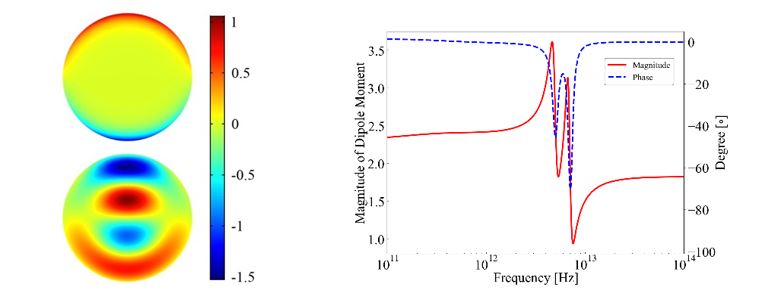Video Article Open Access
Polarization Coupling in an Asymmetrical Semiconductor Nanodimer
Zi Wang1, Zhijing Hu2, Yanlin Li3, Thomas Wong1,*
1Illinois Institute of Technology, Chicago, IL 60616, USA
2Keysight Technologies, Thousand Oaks, CA 91360, USA
3Qorvo, Inc., Greensboro, NC 27409, USA
Vid. Proc. Adv. Mater., Volume 2, Article ID 2108227 (2021)
DOI: 10.5185/vpoam.2021.08227
Publication Date (Web): 23 Jul 2022
Copyright © IAAM
Graphical Abstract

Abstract
A dimer is a simple form of cluster bearing the salient characteristics of polarization interactions between the constituent particles while being amenable to tractable analysis. Semiconductor nanoparticles (SNP) exhibit surface plasmon resonance (SPR) in the terahertz range, for which they are receiving considerable interest as impetus for device and circuitry applications in that part of the electromagnetic spectrum. The provision for variation in charge concentration by doping of semiconductors adds a degree of freedom in the design of semiconductor nanostructures not easily achieved with metals, allowing for applications in wider frequency range and adjustment in polarization spectral response. A semiconductor nanodimer (SND) formed by two SNPs with unequal doping levels exhibits a dipole moment spectrum with unique signature resulting from the interference in the secondary field arising from the polarizations in the constituent SNPs. In this investigation, the response of an asymmetrical SND in a terahertz electric field is studied by electromagnetic simulation with transport formulation for charge dynamics in the semiconductor. The observed skewed polarization spectrum can be interpreted in terms of the interference among the secondary field arising from the intrinsic surface plasmon resonance (SPR) of the SNPs, each slightly red shifted as a result of coupling interactions. At the SPR at lower frequency, the charge polarizations in both particles are within 900 phase delay from the applied field, leading to enhancement in the dipole moment. On the other hand, at the SPR at higher frequency, the particle with lower doping has charge polarization substantially out of phase with the applied field while the particle with higher doping is close in phase with the applied field, leading to a smaller magnitude in the total dipole moment. The intensified electric field in the gap region goes through a process of undulation as the frequency of the applied field is varied over the two SPRs. The phenomenon can be employed to implement field scanning effect in senor applications.
Keywords
Nanodimer, semiconductor, polarization, dipole moment, interference.
References
- L. Gunnarsson, T. Rindzevicius, J. Prikulis, B. Kasemo, M. Kall, S. Zou, and G. Schatz, J. Phys. Chem., 2005, B 109, 1079-1087.
- F. Huang and J. J. Baumberg, Nano Lett., 2010, 10, 1787.
- V. Giannini, A. Berrier, S. A. Maier, J. Antonio Sanchez-Gil, and J. G. Rivas, Opt. Express, 2010, 18, 2797.
- T. Shen, Z. Hu and T. Wong, Electron. Lett., 2013, 49, 52.
- T. Shen, Z. Hu, X. Fu, Y. Li, and T. Wong, Proc. 39th IRMMW-THz Conf., 2014.
Video Proceedings of Advanced Materials

Upcoming Congress



